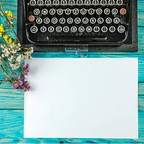Submitting to the flow of creativity (part 2 of 2) (Archived)
Children shine with a confidence and courage adults lack. Their creative worlds are pure, untarnished by doubt, self-disgust or shame. Imagine what we could achieve if we could really be in our creativity, without a harness or a safety net or a nasty internal co-pilot glooping doubt in our ears?
In my last blog (Part 1) I shared a writing activity that gives me short reprieve from that nasty internal voice in my head that poo-poos any tickle of a new idea and sucks the wind out of any attempt to try something new.
My favourite writing activity is modified from a fantastic resource book ‘How to craft a great story’ by Chris Stykes. I created tiny prompt cards modified from his plot tool. I pick six without looking, leave these face down on the desk and turn them over one by one to guide the direction my story takes next. The example selection I gave last blog was: waiting, meets a man, violence, eats, argues, makes a mistake.
The activity can be done an infinite number of times because the character you pull through the activity shapes the way the story played out. In part two of this topic I would like to share other ways I evolved this activity.
One pain-point for me is creating a unique character for what is going to be a short writing exercise that most likely will never be re-read. I veer into laziness and (consciously or subconsciously) clone a character from another piece of my writing. This narrows my creativity and introduces limitations or existing patterns of behaviour or personality in that character that makes the piece stale.
My solution? More cards!
I have generated 36 cards that contain random words about a potential character on sassy pink cards. Some of these include: pregnant, lost, frail, traveller, sad, young. These sit alongside a matching pile of purple cards that tell me something about that character. Examples include: loyal, risk-taking, in love, greedy. There’s an overlap between these two lists and that’s okay, because they are only prompts to jiggle forth ideas.
Before I start a writing activity and turn over that first prompt card, I dream up a vague outline of a character by selecting four cards (two pink and two purple). I choose four because not all four will speak to me. In casting my gaze between the four I glimpse the outline of some character and it’s always different from anyone I have ever written about before.
From the this selection of prompt cards I once drew: ‘building’, ‘pregnant’, ‘betrayal’, ‘redemption’. I wrote about a heavily pregnant stone-mage noblewoman who fled into exile and is lining up for work at a quarry, where she befriends the mage behind her in line. In another example the cards: ‘pregnant, growing, power/abuse’ (card four didn’t speak to me) I produced a piece about a blind, heavily pregnant young woman married to an abusive war-mage, locked in his fortress on the losing side of a war.
The action prompt cards guide the character you begin to create through a fast-paced story. That story further shapes and modifies the character you pictured.
Not every playful romp results in a decent story (these two never went anywhere, but they were a lot of fun to write!). The activity forces me to zig and zag in zany new directions (why, mid-panic, is my endangered heroine suddenly eating?). The unexpected shifts (you keep the action prompt cards face down and turn them over one by one) prevents you from cheating and trying to smooth the story toward the next prompt. You are forced to be creative and make that leap, trying to build a believable bridge between shifts in plot. It’s that leap, that space where I’m forced to stretch, that I kindle pure, un-self-conscious, bold creativity.
I have tried story dice and other activities, but none elicits the creativity and fun this game evokes. What’s essential is that stretch, that jump, that uncomfortable feeling of reaching as I bridge a gap through creativity and quirky ideas. Writing exercises can’t be too comfortable. They need to knock offline that narky internal voice and permission us to surrender to the game and the silliness.
How do you exercise your creativity? How do you ensure the steps are far enough apart that you have to do a wobbly little jump, stepping off the firm ground of comfort and ease to balance on the knife-edge of a truly creative space?
(Posted: 19 Jan 2020. Follow me at: https://nicolewalshauthor.com/)
